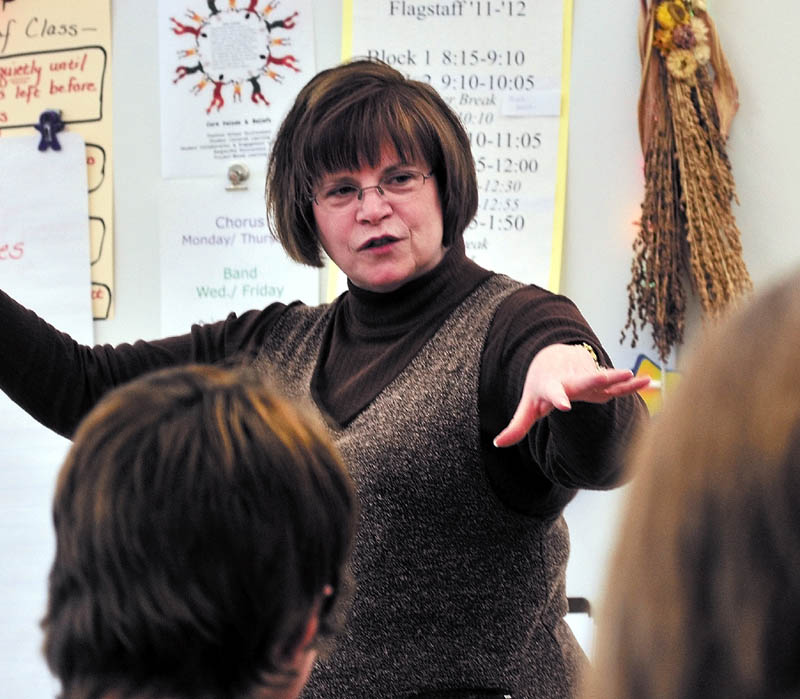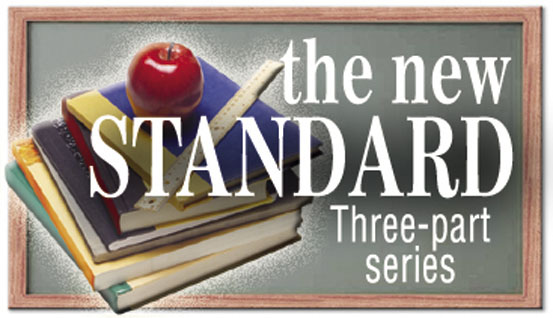Sanger Rainsford is composed and courageous. General Zaroff is a cruel, cold, thrill-seeker.
Linda Haskell’s eighth-grade language arts class at Messalonskee Middle School in Oakland was working on point of view in writing. Their assignment: compare the two main characters from Richard Connell’s short story “The Most Dangerous Game.”
Haskell and a student discussed what format to use.
Haskell told the student Venn diagrams could be hard to get all the writing in, “but Olivia is awesome at those on the computer.”
“You can also do a table,” she added.
Around the room, students uploaded charts, lists and written responses to a software program so Haskell could judge whether they understood “the thoughts, feelings, words, actions, goals and motivation of characters in a story.”
That’s one of Regional School Unit 18’s proficiency standards — or concepts students must show they understand before they can move on to the next one. They can also aim higher by applying a concept or connecting it to other topics.
Letting students choose the kind of work they do and how long they need to do it is at the heart of the education model commonly called proficiency-based, or standards-based, education. At least 22 Maine districts and schools have decided to adopt it and others are looking into it.
All Maine public schools may be required by state officials to institute some form of the model in the coming years.
That means more classrooms will look like Haskell’s, where students work at their own pace, chart their progress and goals and have a place to leave questions and comments.
Schools adopting the model eventually may do away with age-based grade levels, instead grouping students based on what they know and can do.
That sort of change is needed to address stagnation in the traditional American education system, according to Maine Education Commissioner Stephen Bowen.
He said there are core pieces that people think about when they think about school. “And most of what we have done for the last generation, the last 20 to 30 years, has been to sort of nibble around the edges of those” but not change them.
Adopting a proficiency-based system means overhauling nearly every aspect of education, from the posters and charts on classroom walls to the way teachers spend their time and interact with students.
No school in Maine has yet eliminated age-based grade levels. The most visible change so far in most districts — and the one that has drawn the most public questions and complaints — is in the grading system.
In standards-based grading, the traditional A through F is replaced with a 1-4 scale . Students earn a 3 for showing they understand a concept and a 4 if they can also analyze and apply it.
Students must earn at least a 3 to meet the standard and move on to the next one. Those who score lower have to repeat assignments, tests or projects until they get it — it doesn’t matter how much time it takes.
A school district’s standards may also require students to show work ethic, class participation or ability to meet deadlines. Those behavioral standards are reported separately from academic ones, rather than being built into an overall grade, so parents and teachers can distinguish between behavior and learning.
By contrast, traditional education takes snapshots of a student’s abilities and behavior, then averages scores to create an overall grade.
Proponents of proficiency-based education say the system that most schools use now can mask deficiencies and doesn’t answer the most crucial question: what a student really knows.
“At the end of the day, you either know how to multiply fractions or you don’t,” Bowen said. “If you have a C in fractions, what does that mean? If you think about it, the report cards we’ve been using for generations don’t make any sense.”
‘Voice and choice’
Proficiency-based education goes by many names: standards-based, performance-based or competency-based are some used the most.
But a common thread is that students and teachers must work together to figure out the best way a student can learn.
“The intent right off the bat is to intentionally build … more student ownership,” said Linda Laughlin, assistant superintendent in Oakland-based RSU 18. “And when you watch students become more motivated about their learning, and they can speak about their learning, it’s really kind of exciting.”
Educators refer to students having a say as “voice and choice.”
Teachers have always held their students to standards, but the new model removes the veil from the process of learning, said Mark Kostin, Maine liaison for the New England Secondary Schools Consortium, an organization that promotes the reform.
“We have a very clear target that’s not moving for students,” he said. “One of the things I hear about from kids is tremendous excitement and appreciation that what is expected to be successful as a learner is very clear.”
Regional School Unit 2 Superintendent Virgel Hammonds said proficiency-based education relies on giving the students that information.
“Do the kids know what they’re learning, know why, how and how to prove they’ve learned it?” Hammonds said.
In RSU 2, they call the approach “learner-centered instruction.”
Hammonds said traditionally students get information passively by listening to a teacher lecture.
Hammonds was hired as the school district’s superintendent last year specifically because of his dedication to proficiency-based education and his experience with the model as a principal in a California high school.
At Hall-Dale Elementary School in Hallowell, each class started the school year by creating its own code of cooperation.
On the wall of Trish Jamison’s kindergarten classroom, for example, a poster outlines rules and routines. It features a photo of each student demonstrating a step — hanging up a backpack or cleaning up his or her space.
Jamison begins by writing the day’s “learning target” on the whiteboard: greater-than and less-than, for example.
While Jamison works with most of the students on a lesson at the front of the classroom, three others who have already grasped the lesson are sitting at a cluster of desks working separately. They explain their task to Hammonds when he asks.
“They can say not just what they’re working on but why they’re working on that activity,” Hammonds said of the three students. He said when 5- and 6-year-olds can do that, “that’s pretty impressive.”
More independence
A few miles away at Hall-Dale Middle School, Cindy Raymond’s eighth grade language arts students are working on narrative writing.
“You get to teach yourself,” student Anne Wallace said. “There’s not direct instruction every day.”
Wallace is writing a survival story. She gets to write about topics that interest her and her stories often include single-parent families or paralyzed characters because her father broke his neck and then died before she turned 2. For another assignment, she wrote and filmed a movie with a friend.
Messalonskee Middle School social studies and language arts teacher Bobbi Farrell recently invited a speaker to a class about persuasive writing to talk about Internet marketing, and then students created a website or a YouTube video.
But there are limits on students’ choices.
This year’s standards are tougher to meet than last year’s, Messalonskee eighth-grader Katie Guarino said. Farrell usually gives them a range of options so, for example, when in-depth treatment in an essay is more appropriate, they can’t create a poster instead.
Guarino is talkative and articulate and has been tapped for student panels at training sessions to tell teachers why she likes her new way of being taught.
Farrell introduced the model with her seventh-graders last year and was one of only a few teachers in the building using it. Her students said they struggled in transition, particularly with the capacity matrix — the format by which students chart their progress.
“That’s such a big word for a piece of paper that tells us what the goals are,” Guarino said.
Guarino said she hears from high school students that proficiency-based education isn’t used as uniformly there, and some students are resistant to the new system.
“I hope the high school will be better by the time I get there,” she said. “I think if you grew up with it more, it would be easier.”
Information overload?
Hall-Dale High School senior Tyler Boivin said proficiency-based education is kind of scattered, and he’s used to being provided more structure in school. But he also said the new system may have benefits.
“I guess it’s better in the long run because it teaches you to be more independent,” he said.
Boivin is part of the last class at Hall-Dale to get traditional letter grades. RSU 2 students in kindergarten through 11th grade are scored on the new 1 to 4 scale, and next year everyone will be.
That includes junior Brittney Magee, who thinks that parents don’t understand the new grading system. She worries that colleges won’t, either.
Hall-Dale High School is still operating on a time-based system, with credits that take a defined period of time to earn. Magee said students don’t always get to work at their own pace, as promised under proficiency-based education.
“Most of the time we can go as we want, but we can’t get behind,” she said. “They’re pushing us through many units, and we’re not grasping the concepts.”
Although high school students seem to have the most complaints, younger students also acknowledge that proficiency-based education has problems.
“I like it in language arts and I like it in math,” Anne, the eighth-grader, said. “But science and social studies, it’s kind of hard because it’s not knowledge that you already know. You don’t get all the resources you need most of the time.”
When students are learning at different paces, communication between teachers and students becomes even more important, Hammonds said. Teachers must make sure they use software programs and plans designed to chart students’ progress, he said.
Students have the “parking lot,” a section on the wall of each classroom where they can leave suggestions or questions if they don’t understand a lesson.
But Anne she prefers more direct guidance on first exposure to an unfamiliar topic. During a recent unit on flower reproduction, for example, the teacher gave students a list of written sources and websites, assignment deadlines and the test date.
“I got too much information,” she said. “I got a really bad headache.”
Susan McMillan — 621-5645
smcmillan@mainetoday.com
Send questions/comments to the editors.





Success. Please wait for the page to reload. If the page does not reload within 5 seconds, please refresh the page.
Enter your email and password to access comments.
Hi, to comment on stories you must . This profile is in addition to your subscription and website login.
Already have a commenting profile? .
Invalid username/password.
Please check your email to confirm and complete your registration.
Only subscribers are eligible to post comments. Please subscribe or login first for digital access. Here’s why.
Use the form below to reset your password. When you've submitted your account email, we will send an email with a reset code.